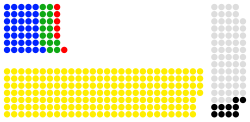Parliament of Uganda
| Parliament of Uganda | |
|---|---|
| 10th Parliament | |
 |
|
| Type | |
| Type | |
| Structure | |
| Seats | 426 |
 |
|
|
Political groups
|
Government (293) Opposition (57) Others
|
| Elections | |
|
Last election
|
18 February 2016 |
| Meeting place | |
 |
|
| Parliament Avenue, Kampala | |
| Website | |
| www |
|
Government (293)
Opposition (57)
Others
The unicameral Parliament of Uganda is the country's legislative body.
The most significant of the institution's functions, is to pass laws which will provide good governance in the country. The government ministers are bound to answer to the people's representatives on the floor of the house.Through the various parliamentary committees, parliament scrutinises government programmes, particularly as outlined in the State of the Nation Address by the President. The fiscal issues of the government, such as, taxation and loans need the sanction of the parliament, after appropriate debate.
The Ugandan parliament is composed of 238 Constituency Representatives, 112 District Woman Representatives, 10 Uganda People's Defence Forces Representatives, 5 Representatives of the Youth, 5 Representatives of Persons with Disabilities, 5 Representatives of Workers, and 13 ex officio Members.
The Ugandan Parliament was established in 1962, soon after the country's independence.
This body was then known as the Legislative Council (LEGCO). It had 92 members and was presided over, as Speaker, by Sir John Bowes Griffin, a British lawyer and former Ugandan Chief Justice.
During this period, Prime Minister Milton Obote abrogated the constitution and declared himself President of Uganda in 1966. This parliament also witnessed the abolition of Uganda's traditional kingdoms and the declaration of Uganda as a republic. The Speaker during the Second Parliament was Narendra M. Patel, a Ugandan of Indian descent. This Parliament ended when Idi Amin overthrew Milton Obote's government in January 1971.
Following the overthrow of Idi Amin in April 1979, a new legislative body known as the Uganda Legislative Council was established. With an initial membership of 30, the membership was later increased to 120. This was the Third Parliament and was chaired by Professor Edward Rugumayo. This legislative body continued to function until the general elections of December 1980.
...
Wikipedia
